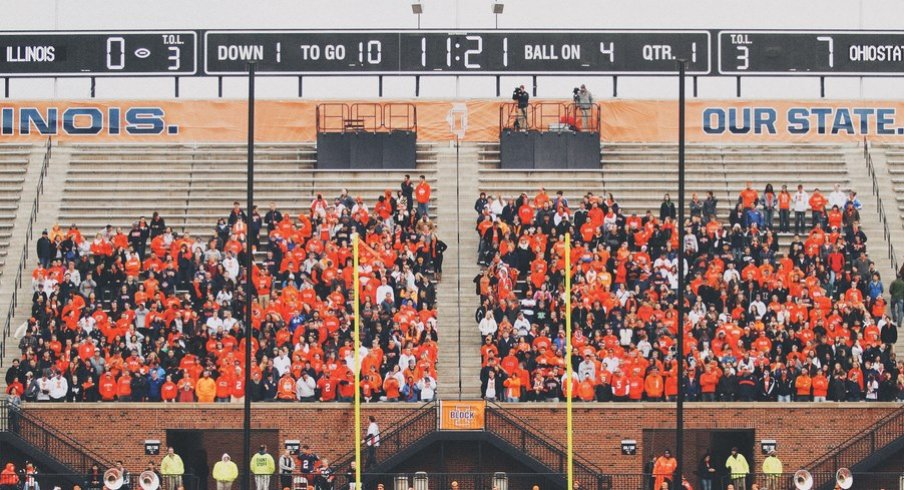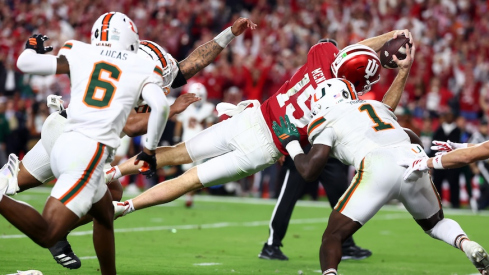Ohio Stadium is a classic, iconic temple of football that is as big a part of the fabric of Ohio State sports as the band or the helmets. We've accepted some relatively small cosmetic changes in the past few years (well, most of us have), but any wholesale changes to either the facade or layout would likely be loudly and vigorously protested by an angry horde of armchair architects almost immediately.
Which is a good thing! What Ohio Stadium looks and sounds like on gameday matters, and it matters because people are still packing in and making a central part of the gameday experience. That Ohio State will be removing approximately 2600 seats is more of a reflection of their current marketing approach rather than getting rid of seats because of a lack of consumer demand.
That is not the case at every Big Ten school, and as a result, some have made alterations to their layout, ostensibly to create "a better fan experience," but more accurately because attendance is down in college football overall. More and more programs are beginning to tacitly acknowledge that fact, including one really surprising example:
“Beaver Stadium will get a little bit smaller,” said [Penn State AD Sandy] Barbour. “As you look at doing a wider seat and a longer tread, there's no way not to get smaller. I don't think it will be significant, but this seems to be the direction folks are going.”
Though she couldn't be specific about a potential number, Barbour did note that she anticipates Beaver Stadium's capacity remaining at more than 100,000.
Barbour mentions that, like Ohio State, Penn State is interested in creating more luxury seats to increase revenue, but when I read this I suspected that there was more in play. Penn State has every reason to be bearish on their projected future attendance for a variety of reasons, and given that they at one point sported a stadium with a capacity over 107,000, they could probably afford to lose a few seats to progress. So I get it; if a school like Ohio State or Penn State or Michigan wants to make some quick cash, they can take out a few seats here, add a few there, and rearrange some things to make some more money on box seats.
But I believe that there's a lot more going on here than that. College football attendance has been trending downward for over a decade. It's leveled off somewhat in the last few years, but major college football teams, even in the Big Ten, have been particularly hit hard by declining numbers of fans coming through the gates. The result has been towering concrete stadiums sitting half-empty on Saturdays in the fall.
So: downsizing. To figure out which Big Ten teams should or could go that route in the future (if they aren't already), here's a handy chart, using data from the BTN:
| SCHOOL | 2015 Average attendance | Stadium capacity | % Capacity Filled |
|---|---|---|---|
| Michigan | 110,168 | 107,601 | 102% |
| Ohio State | 107,244 | 104,944 | 102% |
| Penn State | 99,799 | 106,572 | 94% |
| Nebraska | 89,998 | 90,000 | 100% |
| Wisconsin | 78,014 | 80,321 | 97% |
| Michigan State | 74,661 | 75,005 | 99% |
| Iowa | 63,142 | 70,585 | 89% |
| Minnesota | 52,355 | 52,525 | 99% |
| Rutgers | 47,723 | 52,454 | 91% |
| Maryland | 44,341 | 51,802 | 85% |
| Illinois | 44,314 | 60,670 | 73% |
| Indiana | 41,342 | 52,929 | 78% |
| Purdue | 37,508 | 57,236 | 65% |
| Northwestern | 33,366 | 47,130 | 70% |
What's telling is that there is a stark difference between the haves and the have nots; while the haves are certainly not immune from declining college football attendance, the have nots of the conference are hanging from a precipice that they're unlikely to come back from soon (unless they, you know, stop sucking).
The raw numbers may not look terrible, but a few examples to illustrate my point: TCF Bank Stadium, the new home of Minnesota football, has a capacity of 52,525. This past season they were filled to capacity on a regular basis, which is in part because of their move from the Hubert H. Humphrey Metrodome, which had a capacity of 64,121. When building their new field, the University of Minnesota wisely decided to reduce the amount of seats by nearly 12,000, in part because they knew that was about the ceiling for a Minnesota college football team in an outdoor stadium. For most college football teams in the 2010s, that calculation matters more than gigantic monuments to the gridiron.
Second, it's telling that a 10-2 football team like Northwestern still lost 14% of their attendance from 2014. It's my belief that teams have a certain carrying capacity in an era of cable and internet, as teams that would usually enjoy heavy local support now no longer have that same loyalty. The Buckeyes may not have to sell themselves to Columbus, but the Hoosiers, Illini, Boilermakers, and Wildcats are finding themselves with less and less of a monopoly in their hometowns. It's even more telling that this disconnect has emerged as the average Big Ten attendance overall has gone down steadily in the last three years (thanks, addition of Rutgers and Maryland).
Bloated schedules against poor teams, cost of a ticket, poor play, and a lack of amenities in many stadiums are all driving attendance down. While it's unlikely that Ohio Stadium is likely to get a major downsizing facelift any time in the future, it wouldn't be surprising if the bottom quarter or third of the Big Ten starts to think about whether it's worth it to maintain large, increasingly empty monoliths and instead pivot to smaller, more locally attractive football fields.


